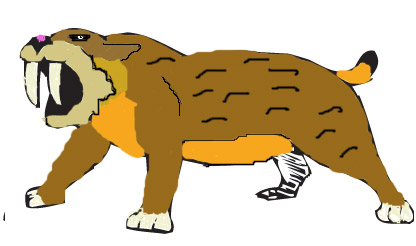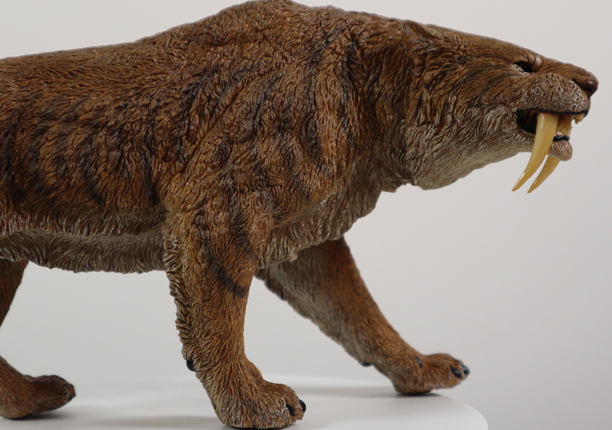Open Wide – The Bite Force and Attack Strategy of Smilodon
New Study Sheds Light on the Bite Force and Gape of Smilodon spp.
The large, sabre-like teeth of Smilodon (Sabre-toothed Cat) were too fragile and likely to be damaged if this member of the Machairodontinae bit down onto bone. How the large canines of these predators were used, has been the subject of considerable debate. Some scientists have even suggested that the sabre-teeth were highly ornamental and only used for display, perhaps to intimidate other members of the pride and to establish a social hierarchy. It had been argued that the row of forward pointing incisors in the upper jaw were the main killing teeth and these teeth were also the most effective at stripping meat from any kills.
An Illustration of Smilodon (Sabre-Tooth Cat)

Picture credit: Everything Dinosaur
What has been established, is that Smilodon was able to open its jaws far wider than any species of extant Felidae. The wide gape was an adaptation to having over-sized teeth in the jaws. But how strong a bite and indeed, how the jaw muscles evolved to permit such a gape have been the subject of a new study, the results of which have been published in this month’s edition of the Zoological Journal of the Linnean Society.
The new analysis, carried out by scientists from Aalborg University (Denmark), reveals that the Smilodon’s jaw muscles evolved into a specialised pattern, which allowed them to open their mouths so wide. The study was led by Dr Per Christiansen, who used a complex model to assess how the muscles in the jaws evolved.
Pictures show a modern big cat’s jaws on the left with the lower jaw opened as wide as it can be without damage to the jaw and the jaw muscles. This is compared in the picture above to the jaws of an extinct Smilodon spp. The jaws of Smilodon can be opened to a much wider angle than a jaws of a modern extant big cat.
Smilodon
His model revealed how the cat’s jaw muscles were aligned to pull its jaws closed, very directly and efficiently. But Smilodon would also have done something that every cat-owner can see a relic of in their own pet.
Dr Christiansen explained:
“When you put a piece of food on the floor for your cat, you’ll see it bobs its head forward as it eats it. And we know that [Smilodon] probably closed its jaws by twisting its head downward and throwing its head forward. Its neck was longer than that of modern cats and its neck muscles would have been stronger.”
The study also examined the earliest and most primitive members of the Machairodontinae, although Dr Christiansen did state that Smilodon in particular was “outrageous in terms of its anatomy”.
He went onto add that Smilodon:
“Was the most [highly evolved and therefore] different from modern cats, so to understand this animal from a biological sense, you need to study more primitive animals to work out why they have become that way through evolution.”
He examined hundreds of skulls, drawing an evolutionary map showing why Sabre-tooths evolved such different jaw anatomy from modern cats.
Dr Christiansen explained that what he termed “killing ecology”, was the driving factor, the evolutionary pressure to kill prey with a deep and efficient stab to the throat.
He stated:
“The cat species became gradually more and more specialised, culminating with monsters such as Smilodon.”
Longer Canine Teeth
As Sabre-toothed cats evolved longer canine teeth, their jaw muscles actually grew smaller, but the fibres became more vertically orientated and thus probably more efficient in closing the jaw.
Dr Christiansen explained:
“At the same time, changes in the way the muscle fibres inserted on the lower jaw meant that the animals could stretch their muscles more – the fibres became re-orientated so as to allow a higher gape, necessary for gaping with huge fangs.”
A Model of a Smilodon (S. populator)

The Rebor Smilodon populator Stray Cat 1/11th scale model shown in close-up view. This is the “plain” colour variant and it has the mouth-closed head attachment. The model is shown in lateral view. Picture credit: Everything Dinosaur.
Picture credit: Everything Dinosaur
However, as specialist carnivores, dependent on large, relatively slow moving prey that they could ambush, this could have been the reason for their demise whilst other members of the Felidae such as leopards, tigers and lions are the apex predators in their environments today.
Everything Dinosaur stocks a wide range of Smilodon models and figures: Models of Prehistoric Mammals.

